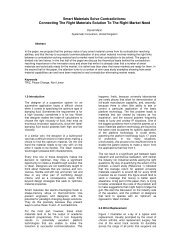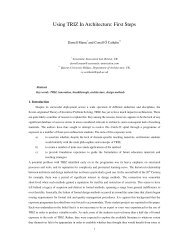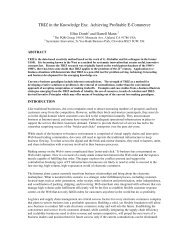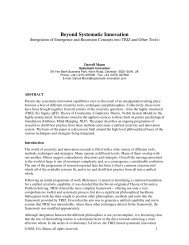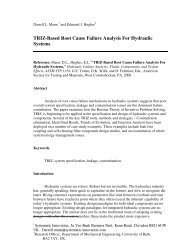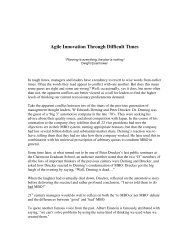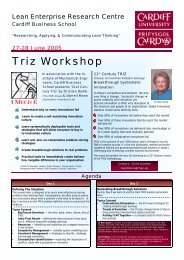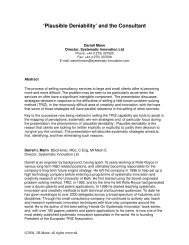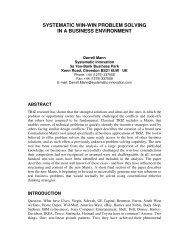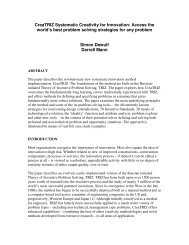Systematic Innovation: An Introduction - Systematic Innovation, TRIZ
Systematic Innovation: An Introduction - Systematic Innovation, TRIZ
Systematic Innovation: An Introduction - Systematic Innovation, TRIZ
You also want an ePaper? Increase the reach of your titles
YUMPU automatically turns print PDFs into web optimized ePapers that Google loves.
<strong>Systematic</strong> <strong>Innovation</strong>: <strong>An</strong> <strong>Introduction</strong><br />
©2006, <strong>Systematic</strong> <strong>Innovation</strong> Ltd<br />
SYSTEMATIC INNOVATION: AN<br />
INTRODUCTION<br />
Darrell Mann<br />
<strong>Systematic</strong> <strong>Innovation</strong> Ltd, UK.<br />
Phone: +44 (1275) 337500, Fax: +44 (1275) 337509<br />
E-mail: darrell.mann@systematic-innovation.com<br />
www.systematic-innovation.com<br />
Abstract<br />
Imagine the biggest study of human creativity ever conducted. Picture the systematic study of<br />
over two million of the world’s most successful patents, and the construction of a problem<br />
solving method which then combines those solutions into a whole that strips away all<br />
boundaries between different industries. Now imagine that it exists. What you’re seeing is<br />
<strong>Systematic</strong> <strong>Innovation</strong>. The reason you may not have heard of it before, is that it was initially<br />
devised and developed as ‘<strong>TRIZ</strong>’ in the former Soviet Union, and practically no-one outside<br />
the Eastern Bloc had heard of it before the fall of the Berlin Wall. In this chapter, we examine<br />
what that Soviet research achieved and how that platform has now been transformed into a<br />
comprehensive <strong>Systematic</strong> <strong>Innovation</strong> methodology, suitable for all types of innovation and<br />
innovation management issues. In the chapter we show how today’s version of the method is<br />
helping users to systematically and reliably create breakthrough solutions to problems of all<br />
descriptions.<br />
<strong>Introduction</strong><br />
<strong>TRIZ</strong> stands for Teoriya Resheniya Izobreatatelskikh Zadatch, which, translated into<br />
English approximates to the Theory of Inventive Problem Solving. <strong>TRIZ</strong> research<br />
began in 1946 when engineer Genrich Altshuller was tasked with studying patents<br />
(Reference 1). <strong>TRIZ</strong> and its ‘<strong>Systematic</strong> <strong>Innovation</strong>’ updates today represent the<br />
output of over 2000 person years worth of research into not just patents, but<br />
successful problem solutions from all areas of human endeavour (Reference 2). The<br />
main findings of <strong>Systematic</strong> <strong>Innovation</strong> are:-<br />
1. That the same problems and solutions appear again and again across different<br />
industries, but that most organisations tend to re-invent the wheel rather than look<br />
outside their own experiences or the experiences of their direct competitors.<br />
2. That the most powerful solutions are the ones that successfully eliminate the<br />
compromises and trade-offs conventionally viewed as inherent in systems.<br />
3. That there are only a small number of possible strategies for overcoming such<br />
contradictions.<br />
1
<strong>Systematic</strong> <strong>Innovation</strong>: <strong>An</strong> <strong>Introduction</strong><br />
©2006, <strong>Systematic</strong> <strong>Innovation</strong> Ltd<br />
4. That the most powerful solutions also make maximum use of resources. Most<br />
organisations are highly inclined to solve problems by adding things rather than<br />
making the current things work more effectively, or transforming the things viewed<br />
as harmful into something useful.<br />
5. That technology evolution trends follow highly predictable paths.<br />
<strong>TRIZ</strong> was barely visible outside the Soviet Union until the fall of the Iron Curtain. Since<br />
then, the spread of the method has been relatively slow, thanks to a combination of<br />
language and cultural mismatches and the reluctance of organisations using <strong>TRIZ</strong> to<br />
describe their successes (and failures) to others.<br />
This short chapter is intended to give newcomers enough information to determine<br />
whether <strong>TRIZ</strong>/systematic <strong>Innovation</strong> has got something to offer them. <strong>Systematic</strong><br />
<strong>Innovation</strong> works on several levels – Figure 1 – firstly a collection of tools, secondly a<br />
complete process that links different tools together for any given innovation situation,<br />
and thirdly a series of philosophical ideas. In the first section, the chapter focuses on<br />
these ideas and the impact they have on the way problems and opportunities are<br />
defined. The second section then outlines a simplified case study in which one of the<br />
basic tools is used to solve a typical manufacture quality problem. A third, final,<br />
section then outlines strategies for finding out more about and deploying the method.<br />
Excellence<br />
Ideality<br />
Resource<br />
Functionality<br />
Contradiction<br />
Space/Time/Interface<br />
Philosophy<br />
A complete problem<br />
definition/solving process<br />
Method<br />
Inventive Principles<br />
S-Fields<br />
PI Tools<br />
Contradiction Matrix<br />
Function<br />
<strong>An</strong>alysis<br />
Knowledge/<br />
Effects<br />
IFR<br />
Trends<br />
Subversion<br />
<strong>An</strong>alysis<br />
Tool<br />
Trimming<br />
Resources<br />
Separation Principles<br />
Figure 1: Tool, Method & Philosophical Levels of <strong>Systematic</strong> <strong>Innovation</strong><br />
2
<strong>Systematic</strong> <strong>Innovation</strong>: <strong>An</strong> <strong>Introduction</strong><br />
©2006, <strong>Systematic</strong> <strong>Innovation</strong> Ltd<br />
Philosophy of <strong>Systematic</strong> <strong>Innovation</strong> – Five Pillars<br />
At its highest level, <strong>Systematic</strong> <strong>Innovation</strong> may be thought of as the distillation of<br />
excellence into a single, unified entity. Excellence in this case means best practice<br />
from every area of endeavour. One of the early discoveries of Genrich Altshuller and<br />
now one of the big ideas encompassed in <strong>Systematic</strong> <strong>Innovation</strong> is that amongst this<br />
excellence, someone, somewhere has already solved your problem.<br />
To some people this statement might sound quite threatening. This is particularly so if,<br />
for example, we are a leader in our particular discipline and have been working on a<br />
problem for a long period of time. <strong>Systematic</strong> <strong>Innovation</strong> recognises that a world<br />
expert in their field is exactly that. It also recognises that being an expert in a field is a<br />
full-time job. Few if any experts in one field have the time to become familiar with other<br />
fields. This, then, is where the method becomes an opportunity rather than a threat.<br />
<strong>TRIZ</strong> research uncovered the fact that very different industries are all solving very<br />
similar problems, and that by constructing an appropriate framework for knowledge it<br />
makes it possible to systematically bridge the gaps that traditionally exist between<br />
different the industries and sciences. The expert, therefore, is offered the opportunity<br />
to see how experts in other fields have solved similar problems. Even if, at first sight,<br />
those problems do not appear to be the same.<br />
There are, of course, two sides to this story. The first is that we have a problem. In this<br />
case, <strong>Systematic</strong> <strong>Innovation</strong> will allow us to identify who and how that problem has<br />
been solved in other sectors. The second possibility is that we already have a solution.<br />
In this situation the method can be used to systematically connect us to industries that<br />
have not yet solved their own problems, and hence provide an opportunity to more<br />
fully exploit what we already possess.<br />
In both directions, <strong>Systematic</strong> <strong>Innovation</strong> provides means for problem solvers to<br />
access the good solutions obtained by the world’s finest inventive minds. The basic<br />
process by which this occurs is illustrated in Figure 2. Essentially, researchers have<br />
encapsulated the principles of good inventive practice and set them into a globally<br />
generic problem-solving framework. The task of problem definers and problem solvers<br />
using the large majority of the <strong>Systematic</strong> <strong>Innovation</strong> tools thus becomes one in which<br />
they have to map their specific problems and solutions to and from this generic<br />
framework.<br />
3
<strong>Systematic</strong> <strong>Innovation</strong>: <strong>An</strong> <strong>Introduction</strong><br />
©2006, <strong>Systematic</strong> <strong>Innovation</strong> Ltd<br />
<strong>TRIZ</strong><br />
GENERIC<br />
PROBLEM<br />
<strong>TRIZ</strong><br />
GENERIC<br />
SOLUTION<br />
SPECIFIC<br />
PROBLEM<br />
SPECIFIC<br />
SOLUTION<br />
Figure 2: The Basic <strong>TRIZ</strong> Problem Solving Process<br />
Beyond this big idea of distilling all knowledge into a common framework, there are<br />
then five central philosophies underpinning the method. <strong>Systematic</strong> <strong>Innovation</strong> can be<br />
used without knowledge of these pillars, and indeed many users are happy to simply<br />
take one or two tools from the toolkit. Nevertheless, appreciation of these big ideas<br />
undoubtedly increases the likelihood that the method will deliver significant tangible<br />
benefit. The pillars are described in no particular order below:<br />
Ideality<br />
Ideality is in many ways similar to the concept of ‘value’. Ideality is defined as the sum<br />
of the benefits that a system delivers to its user divided by the sum of the cost of<br />
delivering those benefits and the any other negative side-effects that may occur<br />
(waste, waiting time, environmental damage, etc). The original <strong>TRIZ</strong> researchers<br />
identified a very simple phenomenon common to all successful innovations – that they<br />
all delivered a higher level of ideality than the products and processes that preceded<br />
them. Hopefully the idea that we should give customers more good things and less<br />
bad if we are going to be successful is not a great surprise. It does mean, however,<br />
that there is a definable direction of success. More interesting than this idea of<br />
direction is the concept of a final destination. In <strong>Systematic</strong> <strong>Innovation</strong> this final<br />
destination is known as the Ideal Final Result (IFR). The IFR is defined as that point<br />
when the customer gets all the benefits they want, without any of the costs or harms.<br />
While this concept might sound very theoretical, at the very least it offers a long term<br />
evolution goal.<br />
4
<strong>Systematic</strong> <strong>Innovation</strong>: <strong>An</strong> <strong>Introduction</strong><br />
©2006, <strong>Systematic</strong> <strong>Innovation</strong> Ltd<br />
Related to this evolution towards the IFR (recognising that every customer will<br />
potentially have a different definition of the IFR of course) is the knowledge that<br />
systems evolve through a series of discontinuous jumps or s-curves. Figure 3<br />
illustrates a fundamental dynamic governing the evolution of all systems – any<br />
individual system will improve up to a point where it is incapable of improving further,<br />
then, provided the customer is demanding further improvements, the only way forward<br />
is to make a discontinuous jump to another system. The evolution of systems towards<br />
the IFR destination may thus be seen as a series of discontinuous jumps.<br />
IDEALITY = Benefits/(Costs + Harm)<br />
IFR<br />
X<br />
final GEN…..<br />
2nd GEN<br />
1st GEN<br />
Figure 3: The Fundamental Dynamics Of System Evolution<br />
TIME<br />
The next key finding of <strong>Systematic</strong> <strong>Innovation</strong> is that the steps denoting a shift from<br />
one S-curve to the next are highly predictable. This may sound difficult to believe, but<br />
the overwhelming evidence from the analysis of all of the successful solutions is that<br />
there are a number of patterns of discontinuous jumps that repeat faithfully across<br />
different industries. This chapter does not set out to ‘prove’ that these trend patterns<br />
are correct, but instead merely asks the users to speculate on the impact that<br />
predictable evolution would have on their business and the way it thinks about its<br />
future relative to competitors.<br />
5
<strong>Systematic</strong> <strong>Innovation</strong>: <strong>An</strong> <strong>Introduction</strong><br />
©2006, <strong>Systematic</strong> <strong>Innovation</strong> Ltd<br />
Contradictions<br />
Although often the first of the tools seen by newcomers to <strong>TRIZ</strong> or <strong>Systematic</strong><br />
<strong>Innovation</strong>, Contradictions is probably the tool which is deployed least well. At least<br />
part of the reason for this is that the main underlying principle of the Contradictions<br />
philosophy – that of seeking to identify and eliminate contradictions, trade-offs,<br />
paradoxes, conflicts or whatever other term we might use – is almost the complete<br />
opposite of traditional problem solving strategies. In nearly all problem solving<br />
methodologies the emphasis is very firmly placed on the importance of achieving<br />
‘optimum’ compromises between conflicting problem parameters. There is a strong<br />
tendency in a traditional design approach, in fact, to think of the design process as an<br />
amorphous bag filled with an incompressible fluid made from the different design<br />
parameters – Figure 4 – in which, as the designer tries to squash the bag to improve<br />
one parameter, it bulges out somewhere else as a different parameter gets worse.<br />
Weight<br />
Volume<br />
Cost<br />
Environmental<br />
Impact<br />
Manufacturability<br />
Use-ability<br />
Durability<br />
Efficiency<br />
Reliability<br />
Performance<br />
etc<br />
Figure 4: The Design Process As <strong>An</strong> Incompressible-Fluid Filled Bag<br />
The keen emphasis on ‘trade-off’ solutions in traditional problem solving practice often<br />
means that problem owners are rarely explicitly aware that conflicts exist. The first<br />
major part of the paradigm shift that takes place in the Contradictions part of <strong>TRIZ</strong> is<br />
the need for problem solvers to actively seek out the conflicts and contradictions<br />
inherent in all systems. The second part then involves using the <strong>Systematic</strong> <strong>Innovation</strong><br />
methodology to try and ‘eliminate’ (Reference 3) those contradictions rather than to<br />
6
<strong>Systematic</strong> <strong>Innovation</strong>: <strong>An</strong> <strong>Introduction</strong><br />
©2006, <strong>Systematic</strong> <strong>Innovation</strong> Ltd<br />
accept them. Or, in terms of the incompressible-fluid filled bag analogy, the aim is to<br />
attach a valve of some kind which allows the amount of fluid in the bag to be changed.<br />
Once contradictions have been identified, <strong>Systematic</strong> <strong>Innovation</strong> contains a number of<br />
‘contradiction elimination’ tools – primarily the Contradiction Matrix (References 3 and<br />
4) – which encapsulate how others have successfully solved similar problems. At this<br />
point in time, the research has identified 40 Inventive Principles which might apply in<br />
any given contradiction situation. The Contradiction Matrix allows problem solvers to<br />
narrow down that list of 40 to a more manageable five or six Principles which might<br />
apply to an individual contradiction type. There may, of course, ultimately be more<br />
than 40 Principles. As of today, however, wherever researchers look, we see the<br />
same 40.<br />
Contradiction elimination is one of the most powerful of the <strong>Systematic</strong> <strong>Innovation</strong><br />
problem solving tools. A common phenomenon when problem contradictions are<br />
eliminated instead of traded-off is that the benefits tend to extend beyond those<br />
initially targeted during the problem solving process (References 5 and 6).<br />
In terms of evolutionary S-curves, it is the emergence of limiting contradictions<br />
(Reference 7) that ultimately restrict the ability of systems to give all of the benefits<br />
that customers desire and give the S-curve its characteristic flattened profile at the<br />
mature end of the curve. The <strong>TRIZ</strong> contradiction elimination tools thus have a very<br />
important role to play in allowing systems to transition from one S-curve to another.<br />
Functionality<br />
Although the functionality aspects of <strong>Systematic</strong> <strong>Innovation</strong> owe a significant debt to<br />
the pioneering work on Value Engineering by Miles (Reference 8), the method of<br />
defining and using functionality data is markedly different; sufficient at the very least to<br />
merit discussion as a distinct paradigm shift in thinking relative to traditional occidental<br />
thought processes. Three aspects are worthy of particular note:-<br />
1) The idea that a system possesses a Main Useful Function (MUF) and that any<br />
system component which does not contribute towards the achievement of this<br />
function is ultimately harmful. In a heat exchanger, for example, the MUF is to<br />
7
<strong>Systematic</strong> <strong>Innovation</strong>: <strong>An</strong> <strong>Introduction</strong><br />
©2006, <strong>Systematic</strong> <strong>Innovation</strong> Ltd<br />
transfer heat to the working medium; everything else in the system is there solely<br />
because we don’t yet know how to achieve the MUF without the support of the<br />
ancillary components. (Systems may of course perform several additional useful<br />
functions according to the requirements of the customer.)<br />
2) In traditional function mapping, the emphasis is very much on the establishment of<br />
positive functional relationships between components. <strong>Systematic</strong> <strong>Innovation</strong><br />
places considerable emphasis on plotting both the positive and the negative<br />
relationships contained in a system, and, more importantly, on using the function<br />
analysis as a means of identifying the contradictions in a system.<br />
3) Functionality is the common thread by which it becomes possible to share<br />
knowledge between widely differing industries. A motor car is a specific solution to<br />
the generic function ‘move people’, just as a washing powder is a specific solution<br />
to the generic function ‘remove object’. By classifying and arranging knowledge by<br />
function, it becomes possible for manufacturers of washing powder to examine<br />
how other industries have achieved the same basic ‘remove solid object’ function.<br />
‘Solutions change, functions stay the same’ is a message which forms a central<br />
thread in the <strong>TRIZ</strong> methodology: People want a hole not a drill. Functions, it should<br />
additionally be noted can be both tangible (‘remove solid object’) and intangible<br />
(‘feel nice to the touch’).<br />
A number of functionally classified knowledge databases for at least the tangible<br />
functions are now becoming commercially available. A free version is available at<br />
Reference 9.<br />
Use Of Resources<br />
The fourth of the five philosophical pillars of <strong>TRIZ</strong> is the simplest, and relates to the<br />
unprecedented emphasis placed on the maximisation of use of everything contained<br />
within a system. In <strong>TRIZ</strong> terms, a resource is anything in the system which is not being<br />
used to its maximum potential. <strong>TRIZ</strong> demands an aggressive and seemingly relentless<br />
pursuit of things in (and around) a system which are not being used to their maximum<br />
potential. Discovery of such resources then reveals opportunities through which the<br />
design of a system may be improved.<br />
8
<strong>Systematic</strong> <strong>Innovation</strong>: <strong>An</strong> <strong>Introduction</strong><br />
©2006, <strong>Systematic</strong> <strong>Innovation</strong> Ltd<br />
In addition to this relentless pursuit of resources, <strong>TRIZ</strong> demands that the search for<br />
resources also take due account of negative as well as the traditionally positive<br />
resources in a system. In <strong>Systematic</strong> <strong>Innovation</strong> terms, even the bad stuff is good<br />
stuff – we merely haven’t thought hard enough yet about how to make the<br />
transformation from lemons to lemonade. By way of an example of this ‘turning<br />
lemons into lemonade’ concept, practitioners often think of resonance as a resource.<br />
This is in direct contradiction to most practice, where resonance is commonly viewed<br />
as something to be avoided at all costs. <strong>Systematic</strong> <strong>Innovation</strong> says that somewhere,<br />
somehow, resonance in a system can be used to beneficial effect. In effect, resonance<br />
is a potent force lever capable of amplifying small inputs into large outputs.<br />
Resonance is currently being used to generate beneficial effects in a number of new<br />
product developments from vacuum cleaners (resonating carpet fibres to enhance<br />
extraction of dust particles), paint stripping systems on ships (firing a pulsed jet of<br />
water – existing resource! – at the local resonant frequency of the hull), and in helping<br />
to empty trucks carrying powder-based substances more quickly.<br />
Space, Time, Interface<br />
The fifth pillar of <strong>Systematic</strong> <strong>Innovation</strong> is about perspective on problems. Our<br />
perspective on a situation plays a very important role in determining the solutions we<br />
derive. It is therefore very important to be able to look at things from many different<br />
view points – not only physically and temporally, but also the relationships and<br />
interfaces between the things can be as important as the things themselves. The<br />
human brain has not evolved to be creative. It has evolved to absorb sparse data and<br />
make decisions on that data. Sometimes – as in an emergency – this decision making<br />
process has to happen very quickly. As a result, the brain very quickly makes<br />
assumptions about what a problem is and what to do about it. Unfortunately, the brain<br />
very often jumps to what turns out to be the wrong definition of the situation. The<br />
space-time-interface pillar of the method is about enabling users to systematically reframe<br />
their thinking in order to avoid the problem of jumping to the wrong problem<br />
definition. The space-time-interface pillar of systematic innovation is where the<br />
internal workings of the brain meet the outside world – Figure 5. In any creative<br />
problem solving session it is helpful to accommodate both domains.<br />
9
<strong>Systematic</strong> <strong>Innovation</strong>: <strong>An</strong> <strong>Introduction</strong><br />
©2006, <strong>Systematic</strong> <strong>Innovation</strong> Ltd<br />
TRADITIONAL CREATIVITY<br />
APPROACH<br />
<strong>TRIZ</strong> APPROACH<br />
SYSTEMATIC INNOVATION<br />
APPROACH<br />
•Internally focused<br />
•If an internal solution<br />
doesn’t exist, none<br />
will be found<br />
•Techniques involve<br />
‘unblocking’ brain<br />
•Externally focused<br />
•If anyone, anywhere<br />
has solved the problem<br />
(or something like it)<br />
it will be found<br />
•Culture integration issues<br />
•Finding the ‘right’ problem<br />
•Combined approach<br />
•Take a good solution model and<br />
use in-house capabilities/firm<br />
values to integrate it into<br />
the culture<br />
•‘Solution ownership’ is critical<br />
Figure 5: Space-Time-Interface – Utilising Internal <strong>An</strong>d External Worlds<br />
A Simple Case Study<br />
In order to give a flavour of <strong>Systematic</strong> <strong>Innovation</strong> in action and to compare its<br />
approach with that of traditional problem solving methods, this section of the chapter<br />
examines a typical manufacture quality problem. The example relates to the extrusion<br />
of man-made textile fibres. In this operation we are trying to produce fibres of as small<br />
a diameter as possible in order to produce the highest possible appearance and feel in<br />
the finished textile. We are also trying to achieve 6 Sigma levels of quality (i.e. 3.4<br />
failures per million opportunities) during the extrusion process, but unfortunately have<br />
not been able to do so despite considerable experimental effort. The main source of<br />
defects concerns fibre breakage due to localised ‘necking’ – lengths of the fibre that<br />
are lower than specified diameter. The start point for this situation then is our desire to<br />
improve the quality of the extrusion process by reducing the necking problem and<br />
hence reducing the number of fibre breakages.<br />
Once we know what we would like to improve, the next question asked in a simplified<br />
version of the <strong>TRIZ</strong> process would be ‘what is stopping us from making the<br />
improvement?’ The answer to this question may be that we don’t know. If that is the<br />
case then the <strong>Systematic</strong> <strong>Innovation</strong> method will tell us that we need to acquire some<br />
data in order to understand why in this case necking occurs. For most production<br />
processes the desire to optimise processes generally means that we will have a pretty<br />
10
<strong>Systematic</strong> <strong>Innovation</strong>: <strong>An</strong> <strong>Introduction</strong><br />
©2006, <strong>Systematic</strong> <strong>Innovation</strong> Ltd<br />
good idea about what causes variation in the process. In the case of a typical<br />
extrusion operation quality is likely to be related to changes in temperature of the<br />
material, atmospheric temperature, size of the die, pumping pressure, tension on the<br />
fibre after extrusion, atmospheric pressure, humidity, etc. Let us then speculate that<br />
the reason for the presence of necking in the fibre is fluctuation in the temperature of<br />
the molten material before it enters the die. In traditional problem solving analysis, we<br />
might chose to explore this situation further by asking why the temperature<br />
fluctuations occur. Indeed we might take this a step further by experimenting with all of<br />
the other variables in the system to see how they might affect temperature and then<br />
necking. If we did this we might well determine that, for example, it was possible to<br />
reduce the temperature variation problem by slowing down the process (i.e. allowing<br />
more time for the temperature to stabilise throughout the material). With this finding<br />
we now have the potential of a solution to the problem; slowing the process down<br />
improves temperature distribution which in turn reduces breakages. While this might<br />
indeed solve the quality problem, the solution has been achieved at the expense of<br />
throughput. We have improved one thing only for another to get worse. If we<br />
determine that quality is more important than speed then we may be happy with this<br />
decision.<br />
<strong>Systematic</strong> <strong>Innovation</strong> on the other hand will tell us that we have now found a<br />
contradiction. Something gets better and something else gets worse. In the ideal case,<br />
we would find a way of improving the quality without reducing the speed. The<br />
contradictions part of the method contains a Contradiction Matrix tool (Reference 3).<br />
This tool enables users to see how other problem solvers have solved similar<br />
problems without making compromises. In the case of this hypothetical extrusion<br />
process, we have identified that there is a contradiction between our desire for even<br />
temperature distribution and the lack of time for the heat to spread evenly through the<br />
material. According to <strong>TRIZ</strong>, someone, somewhere has already found ways of solving<br />
this problem. Figure 6 illustrates how the Matrix has been used to resolve the problem<br />
in other disciplines.<br />
Figure 6: The Temperature versus Time Contradiction <strong>An</strong>d How Other People Have Solved It<br />
11
<strong>Systematic</strong> <strong>Innovation</strong>: <strong>An</strong> <strong>Introduction</strong><br />
©2006, <strong>Systematic</strong> <strong>Innovation</strong> Ltd<br />
In this case we may see that 9 different Inventive Principles have been used to<br />
successfully resolve this type of temperature-versus-time conflict pair. Closer<br />
examination of the Inventive Principle descriptions (Reference 10) will then reveal<br />
several possible solution options:-<br />
Principle 15, Dynamics – introduce some kind of a stirrer into the system to improve<br />
mixing of hot and cold materials.<br />
Principle 19, Periodic Action – rather than adding a mechanical mixer, use pressure<br />
pulsations to improve mixing of the raw material.<br />
Principle 1, Segmentation – instead of attempting to heat all of the raw material to the<br />
same temperature, recognise that the only time when temperature is important is<br />
when the material enters the die. Hence rather than seeking to accurately control the<br />
temperature of all of the material, segment the problem and only accurately control<br />
that material which is about to enter the die.<br />
Principle 18, Vibration – here we might use some form of vibration (the Principle<br />
actually suggests the use of ultrasound) to improve mixing of the material and hence<br />
the removal of hot spots.<br />
The only limits to the number of solutions that can be found will generally be<br />
dependent on the ability of the problem solver to interpret the Inventive Principles.<br />
With practice it is possible to still be generating viable no-trade-off solutions for several<br />
hours. Compare this with a typical brainstorming session where ideas generally run<br />
out after less than 20-30 minutes.<br />
This quality problem study has been solved as a contradiction problem since – as with<br />
many manufacture systems – there are highly likely to be contradictions present since<br />
we are always trying to get the maximum out of the system that we can. Asking the<br />
pair of questions ‘what would I like to improve?’ and ‘what stops me?’ is a simple and<br />
effective way of identifying these contradictions. <strong>An</strong> alternative problem strategy would<br />
have involved recognising that the problem has got something to do with the even<br />
heating of a liquid. Making this connection, the <strong>Systematic</strong> <strong>Innovation</strong> function<br />
database would have suggested that, looking across every different industry, there are<br />
many ways of delivering this function. We could, for example, seek to deploy acoustic<br />
cavitation or the Joule-Lenz Effect or Ranque Effect or microwave, etc as other<br />
sectors wishing to perform the ‘heat liquid’ function have already discovered for me. If<br />
12
<strong>Systematic</strong> <strong>Innovation</strong>: <strong>An</strong> <strong>Introduction</strong><br />
©2006, <strong>Systematic</strong> <strong>Innovation</strong> Ltd<br />
we have never heard of some of these methods of heating, the database at Reference<br />
9 provides more information on each.<br />
Summary<br />
To try and summarize and give a flavour of the world’s biggest study of creativity and<br />
innovation in a mere dozen pages is an almost impossible task. For anyone that<br />
wishes to explore <strong>TRIZ</strong> or <strong>Systematic</strong> <strong>Innovation</strong> in more detail there is a wealth of<br />
available information on the subject. Much of this information is available for free on<br />
the Internet. See Reference 9, for example, for a collection of over 200 <strong>TRIZ</strong> websites.<br />
Despite the fact that <strong>TRIZ</strong> will tell us that the nuclear, aerospace, bio-sciences, microelectronics,<br />
chemical process, automotive, food, education, politics, HR, literature,<br />
music, logistics, etc sectors are all solving similar problems it is still very difficult to<br />
conceive the possibility that someone has already solved your problem. But that is<br />
indeed what the evidence of over two million analyses will tell us. As companies and<br />
individuals gradually become more willing to talk about what they are doing with <strong>TRIZ</strong>,<br />
it becomes increasingly likely to find something specifically connected with your<br />
situation.<br />
The main success factor with <strong>Systematic</strong> <strong>Innovation</strong> is to get some initial tangible<br />
benefit. To learn the whole of the method will probably require an investment of three<br />
to six months of effort. No-one is going to (or indeed ought to) make this level of<br />
commitment without some faith that the benefits will outweigh the costs. A very<br />
important final word, then, is that there is absolutely no need to learn the whole of the<br />
toolkit before users can start delivering real benefits. Many users will learn one tool<br />
only, and will stick with just that one tool. If that enables them to solve a problem or<br />
create a patent then a major service will have been provided. Then and only then<br />
should the inclination to learn other parts be encouraged. Let the use of <strong>Systematic</strong><br />
<strong>Innovation</strong> grow from the tangible benefits that it delivers.<br />
References<br />
1) Altshuller, G. ‘Creativity As <strong>An</strong> Exact Science’, (Gordon & Breach, 1984)<br />
2) Salamatov, Y., ‘<strong>TRIZ</strong>: The Right Solution At The Right Time’, (Insytec BV, The<br />
Netherlands, 1999)<br />
13
<strong>Systematic</strong> <strong>Innovation</strong>: <strong>An</strong> <strong>Introduction</strong><br />
©2006, <strong>Systematic</strong> <strong>Innovation</strong> Ltd<br />
3) Mann, D.L., Dewulf, S., Zlotin, B., Zusman, A., ’Matrix 2003: Updating The <strong>TRIZ</strong><br />
Contradiction Matrix’, CREAX Press, Belgium, 2003.<br />
4) Mann, D.L., ‘Hands-On <strong>Systematic</strong> <strong>Innovation</strong> for Business & Management’, IFR<br />
Press, 2004.<br />
5) Mann, D.L., ‘Design Without Compromise: A New Perspective on Fluid Power<br />
System Component Design’, PTMC International Workshop, PTMC99, Bath,<br />
September 1999.<br />
6) Mann, D.L., ‘Case Studies In <strong>TRIZ</strong>: Helicopter Particle Separator’, <strong>TRIZ</strong> Journal,<br />
February 1999.<br />
7) Mann, D.L., ’Strength versus Weight Contradictions in Bridge Design’, <strong>TRIZ</strong><br />
Journal, March 2000.<br />
8) Miles, L. D. ‘Techniques of Value <strong>An</strong>alysis and Engineering’, McGraw-Hill Book<br />
Company, New York NY, 1961.<br />
9) www.systematic-innovation.com<br />
10) Mann, D.L., ‘Hands-On <strong>Systematic</strong> <strong>Innovation</strong>’, CREAX Press, 2002.<br />
14



